| Skandinavisme
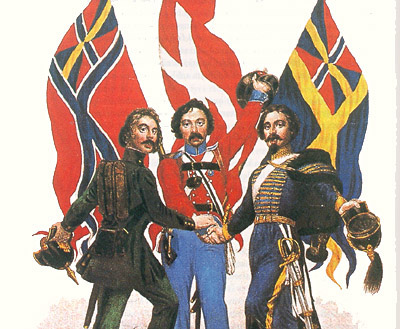
| | Efter 1830 blev kontakterne øget over Øresund. Der blev afholdt fælles videnskabelige kongresser og en række omfattende studentermøder manifesterede den skandinaviske fællesskabsfølelse i årene fremover.
De nye samfærdselsmidler, især dampskibene, muliggjorde disse manifestationer, men en voksende politisk-liberal orientering var også medvirkende til at styrke bevægelsen. |
De kongelige
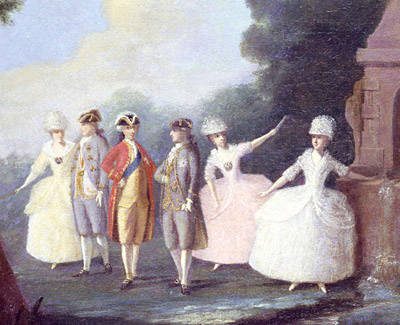
| | Afslutningen på de mange krige imellem Danmark og Sverige og Skånelandenes definitive overgang til Sverige gjorde det vanskeligere at passere Øresund. Der krævedes nu pas for at passere Øresund og samkvem over Sundet, hvilket, i nogen grad, begrænsede de tætte kontakter.
Giftermål imellem kongefamilierne gav impulser til forbedring, men under Napoleonskrigene havner de to lande på hver sin side i konflikten og Norges overgang til forbund med Sverige i 1814 kølner forholdet igen. |
Neutralitetsforbund i 1756
I Danmark er holdningen til Sverige i årtierne efter Store nordiske Krigs afslutning 1720 forholdsvis forsonlig. Danmark har efterhånden endegyldigt affundet sig med at Skånelandene var tabt, mens det i Sverige måske kniber mere med at se den nyligt tabte stormagtsstatus i øjnene.
Begge parter er tidligt opmærksom på de russiske stormagtsambitioner i Østersøområdet og i 1740erne taler den danske embedsmand Schulin om at ”de tre nordiske riger vilde vinde i magt og selvstændighed og lykke” ved en forening. Bestræbelser på at skabe en nordisk personalunion med udgangspunkt i en dansk kronprins midt i århundredet lykkes ikke, men i 1756 sluttes et neutralitetsforbund imellem de to stater.
Skandinavisk kongebryllup
I 1766 ægter den svenske konge Gustav 3. den danske prinsesse Sofie Magdalene. Gustav gæster i 1770 som kronprins Danmark og som svensk regent aflagde han et kort besøg i 1786. Man modtog d. 9.juli kong Gustav på Marienlyst Slot ved Helsingør, hvortil kongen var ankommet klokken 12. Der blev dineret med ledsagelse af tyrkisk kammermusik ved Livgardens oboister og tilkaldte ditto fra Kronborg. Kl. 18 begav man sig til Hellebæk for at bese geværfabrikken og ud på aftenen returnerede den svenske konge så efter dette korte venskabsbesøg.

Gustav 3. på Fredensborg |
Uanmeldt besøg
Kong Gustav vendte tilbage i oktober måned 1787, denne gang på uanmeldt besøg. I den anledning beskrev Tidskriftet ”Minerva”, hvilken stor glæde enhver ”Skandinav” måtte føle ved det fællesskab, som dette besøg fremviste. Således gik det til at ordet Skandinav blev et begreb.
Ret beset var danskerne dog bekymrede ved det sidste besøg, som kom helt bag på hofetiketten og fordi man frygtede for skjulte udenrigspolitiske dagsordener. Allerede under det første besøg havde den danske konge spyttet i suppen og umotiveret forladt måltidet, så man frygtede, hvad den enevældige, men sindsforvirrede kong Christian VII kunne finde på, eller blive lokket til. Gustav havde planer om udvidelser mod øst, men Danmark havde en alliance med Rusland og i 1788 kommer de to parter som følge af alliancen på kant med hinanden.
Gustav 3. myrdes
I 1792 bliver den svenske konge imidlertid myrdet under et maskebal på Stockholms Slot og krigsfaren driver over for denne gang. Samme år holdt den danske professor Sneedorff et foredrag i Det nordiske Selskab i London, om hvor vigtigt det var at de tre nordiske lande forenedes og i 1794 underskrives endnu et væbnet neutralitetsforbund imellem Danmark og Sverige og i den anledning udtaler den danske udenrigsminister Bernsdorff at ”Alt hvad der nærmer Sverige og Danmark til hinanden er naturligt; alt hvad der skiller dem er uretfærdigt og unaturligt”.
Svenskere i dansk eksil
En af de implicerede i mordet på Gustav 3. grev Claes Horn måtte tilbringe sine dage i dansk eksil og ligger begravet på Assistens Kirkegård i København. Den landflygtiges vilkår har ofte været kummerlige og man har været henvist til andres nåde. En Notits skrevet af Grev Horn, formodentlig tiltænkt den danske konge og fundet i en vase på Marienlyst Slot af embedsmanden, geheimeråd Johan Bülow vidner om hans tilstand:
”Ophøjede ejer af disse steder, Deres Folks kærlighed! Forsmå ikke en flygtnings oprigtige hyldest, en flygtning som fra fjerne kyster beskuer sit eget hjemland, idet han jamrer over sin skæbne og alle andre nationers som regeres af konger som ikke ved hvordan de skal efterligne Dem.”
Deltagelse i et mordkomplot er ifølge sagens natur en alvorlig sag, men både Claes Horn og adelsmanden Ehrensvärd tåles og trives i Danmark og tilsyneladende har det ikke slået alvorlige skår i det dansk- svenske forhold i tiden omkring århundredeskiftet.
Napoleonskrigene
På trods af neutralitetsforbundet havnede Sverige og Danmark under Napoleonskrigene atter på hver sin side i den europæiske storkonflikt og det kommer sågar til enkelte mindre sammenstød imellem de to parter i 1808-09 og senest i 1813. Efter avsättningen av den svenske konge Gustav IV Adolf, vælges en dansk prins Christian August til tronfølger, men efter hans bratte død indsættes en tidligere fransk general, Bernadotte på tronen. Bernadotte konverterer til den protestantiske tro på det svenske konsulat i Helsingør og sætter herefter over Sundet.
Resultatet af napoleonskrigene bliver i korte træk at Sverige mister Finland til Rusland i 1809 og Danmark Norge, som i stedet forenedes med Sverige i 1814. Norges overgang til Sverige medfører en nedkøling af det indbyrdes forhold, men i løbet af nogle årtier øges kontakten atter betydeligt bl.a. som følge af en udbedring af samfærdselsmidlerne.

Mindesmærke for Christian August | 
Svenske konsulat i Helsingør | 
Det svenske konsulat i Helsingør | 
Bernadotte i Helsingborg | 
Bernadottemonumentet i Helsingborg |
Litterær Skandinavisme
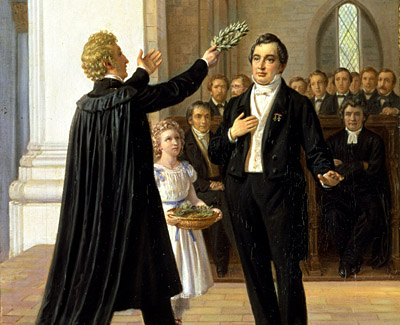
| | I slutningen af 1700-tallet øgedes den gensidige kulturelle interesse og udveksling og i romantikkens tidsalder genopdagedes det fælles nordiske i sprog og litteratur. Dyrkelsen af den nordiske fortid og mytologi førte til et litterært nybrud og dannelse af fælles tidsskrifter og selskaber.
Rejselysten i tiden var stor og det blev også stærkt medvirkende til at skabe kontakter hvor man lærte hinanden bedre at kende. |
I løbet af 1700-tallet er der en voksende kulturel interesse og udveksling imellem Danmark og Sverige, f.eks. dyrkes og beundres Linnés videnskabelige arbejde også i Danmark, Ludvig Holberg komedier finder vej til Sverige og fra anden del af 1700-tallet dyrkes Bellmanns viser også i København.
Litterære forviklinger
Den danske trykkefrihed i slutningen af 1700-tallet giver gode mulighederne for politisk- kuturel udveksling, men da censuren atter indføres i Danmark fører det til en skærpet holdning overfor liberalt orienterede skribenter. En af dem var Peter Andreas Heiberg, som landsforvises for sine skriverier og i første omgang tager ophold i Sverige, hvor han går i militærtjeneste. Senere følges han af Malthe Conrad Bruun som opholder sig i svensk eksil fra 1796-99. Både Heiberg og Bruun var efter tidens målestok radikale skribenter, som revsede enevælden og embedsborgerskabet.
P.A. Heibergs kone bliver tilbage i København, hvor hun har indleder et forhold til en svensker i eksil, Carl Frederik Gyllembourg-Ehrensvärd. Ehrensvärd var impliceret i mordet på den svenske kong Gustav 3.. i 1792, flygtede til Danmark og blev i Sverige frataget sine titler og beføjelser. Thomasine Heiberg bliver med henvisning til sin mands, altså P.A. Heibergs, landflygtighed skilt fra ham og ægter Ehrensvärd under navnet Gyllembourg. Thomasine Gyllembourg bliver den nok mest kendte kvindelige forfatter i første del af 1800-tallets Danmark og er moder til tidens mest fremtrædende smagsdommer Johan Ludvig Heiberg.
Skandinavisk Litteraturselskab
Allerede i 1796 dannedes Skandinavisk Litteraturselskab, som udgav et tidsskrift, som hed Skandinavisk Museum. Det var da Danmark som var ledende i disse enhedsbestræbelser, som naturligvis fik et tilbageslag i sammenhæng med Napoleonskrigen og efter Norges adskillelse fra Danmark. Litteraturforskeren Christian Molbech er en nøgleperson i den kulturelle udveksling, som for hans eget vedkommende bygger på gentagne rejser i det svenske, selvom han i forbindelse med Napoleonskrigenes forviklinger blev mistænkt for spionage og forment adgang til Stockholmsområdet.

Christian Molbech |
Nye strømninger
Der gik dog ikke mere end et par årtier før end der atter kom gang i disse bestræbelser, nu godt hjulpet på vej af romantikken og liberalismens strømninger ude omkring i Europa. Den nye klasse, borgerskabet, ønskede, uanset dansk eller svensk, tidssvarende politiske forhold og var ikke bundet af de enevældige dynastiers traditionelle modsætnings forhold.
Romantikkens tidsalder og romantikkens opfindelse af begreberne folk og nation påvirkede hele Europa og mange mente at folk med fælles kultur, sprog og tradition skulle slutte sig sammen. Denne nationalisme havde skabt samlingsbestræbelser Europa i f.eks. Tyskland og Italien. Derfor blev det fælles også interessant i Skandinavien, hvor der fandtes en stor fælles kulturarv, som kunne danne udgangspunkt for at forene Danmark og Sverige og lægge låg på det gamle fjendskab. Nu fandtes storheden blot i mindet om fordums storhed. Det er derfor ikke så underligt at man søgte tilbage til gamle tider og fordybede sig i den ældre, agtværdige nordiske historien.
Det fælles nordiske
I Danmark er forfatterne Grundtvig og Ingemann initiativtagere til at genoplive nordisk mytologi, litteratur og tidligere tiders historie. Den danske sprogforsker Rasmus Rask er den der videnskabeligt påviser den nære forbindelse imellem de nordiske sprog. I 1812 kommer Rask sammen med litteraturprofessoren Rasmus Nyerup til Stockholm. De modtages godt af svenske ligesindede, men chikaneres af myndighederne. Danmark bedriver på det tidspunkt kaperkrig imod England, som Sverige er allierede med, og Nyerup mistænkes for i 1810 at have gæstet Sverige i politisk ærinde.
Den gensidige mistillid er fortsat betydelig, men alligevel fremstår Nyerup som et vigtigt kulturelt bindeled frem til sin død 1829 og han inspirerede både Erik Gustaf Geijer og Esaias Tegnér fra Sverige der skrev om den storslåede nordiske historie. De litterære kredse fortsatte med at holde liv i de nordiske minder i den nedkølede periode frem til omkring 1830, hvor skandinavismen atter blusser op.
Rasmus Rasks betydning
I 1816 er Rasmus Rask atter i Sverige, først i Kalmar og d. 12. november i Stockholm, hvor han efter visumproblemer kommer ind og tilbringer en rum tid. Årene 1813-15 havde Rask tilbragt med studier på Island, hvor han grundlægger den sammenlignende sprogvidenskab. Tiden i Stockholm går bl.a. med at studere svensk, russisk og persisk, han oversætter selv sin islandske sproglære, som omfatter oversættelse af betydelige dele af den oldnordiske litteratur, til svensk og den udgives tillige med en angelsaksiske sproglære, som han ikke kunne få nogen til at udgive i København.
Rasmus Rask rolle i forbindelse med at øge interessen for den fælles nordiske kulturarv er betydelig og mens han følte at han i Købehavn konstant måtte kæmpe for anerkendelse, så blev han modtaget med åbne arme i Stockholm. Efterhånden breder der sig et rygte om at Rask måske vil blive i Sverige, hvilket ligefrem vækker opstandelse i København: Et er skandinavisk fællesskabsfølelse noget andet den fædrelandskærlighed, som tiden også dyrker.
Centrum Øresund
Drømmen om det gamle storslåede Norden og nationalistiske samlingsbestræbelser forenedes især i tiden efter 1830 i den bevægelse, som går under navnet ”Skandinavismen”. Dens tyngdepunkt kom til at ligge i Øresundsregionen og her stræbte man på forskellig vis efter at slå kulturel, økonomisk og politisk bro over sundet.
Skåne havde jo været en central del af Danmark før den svenske magtovertagelse, så det var naturligt at en tilnærmelse til Danmark faldt i god jord i dette landskab. Regulære dampskibsforbindelser mellem Skåne og Sjælland startedes med en linje Malmø – København 1828. Dermed var Øresund igen begyndt at fungere som et bindeled og ikke som en ”blå mur” imellem Danmark og Sverige. Den ny teknik og de nye idéer fulgtes ad og kunne også motivere hinandens eksistens.

Dampskibet Ophelia |
Digterkonger i Lund
Den 23 juni 1829 var det promovering i Lunds domkirke.Adam Oehlenschläger var rejst dertil med den nyoprettede dampskibsforbindelse fra København og biskoppen i Växjö, Esaias Tegnér var kommet for at overvære sin søns Kristoffers udnævnelse til doktor. Nordens dikterkonger passede på med at hylde hinanden og Tegnér læste sin nyskrevne digt:
” Adskillelsens tid er forbi (og burde ej have fundet sted i åndens frie, uendelige verden), og beslægtede toner, som klinger over Sundet, henrykker os nu, og især dine. Derfor byder Svea dig en krans, her fører jeg dens tale: tag den af broderlig hånd og bær den til minde om dagen! ”
Denne hændelse betegnes ofte som skandinavismens fødselsdag og ingen af de to skjalde kunne ane, hvilken politisk betydning denne hændelse skulle få.

Tegnér og Oehlenschläger |
Skandinavismen styrkes
Forbindelsen imellem svenske og danske litterater styrkes væsentligt i de følgende år, hvor P. Atterbom har snæver kontakt med de danske romantiske digtere Carsten Hauch og Ingemann. Sidstnævnte rejser i 1833 til Sverige og skriver i den forbindelse et digt om Nordens Ånd.
Omkring samme tidpunkt findes de føsrte politiske synspunkter omkring en politisk-statslig forening, således som den senere nationalliberale, danske politiker T.S.Tscernings efterladte papirere vidner om. Der er endnu hovedsagelig tale om en åndelig bevægelse for Nordens enhed, romantisk inspireret, men ikke liberal-politisk i sin orientering.
Den jyske digter Steen Steensen Blicher, der gæster Sverige i 1836, havde også dette relativ upolitiske udgangspunkt, selvom han bliver en hovedkraft i forsøget på at give skandinavismen en mere folkelig forankring ved at knytte den til sine jyske Himmelbjergsmøder i 1840erne. I året 1843 er der således en del svenske deltagere, som Blicher henvender sig til på deres modersmål.
Folkefest
En mere folkelig-politisk drejning får begivenhederne også med etableringen af de såkaldte grundlovsfester i Egebækvang Skov syd for Helsingør. Oprindelig fejredes d.28.maj den begyndende demokratisering af det danske stændersamfund, første gang i 1841 med 5-6000 deltagere.
Året efter er der ikke kun lokale deltagere, men også tilrejsende fra Sverige og København, sidstnævnte med damperen Hamlet. Begivenheden vokser til at blive en væsentlig folkelig manifestation af skandinavismen og ønsket om en liberal forfatning, der kommer få år senere i 1849. Højdepunktet for grundlovsfesterne i Egebæksvang er året 1845, hvor der er taler af S. S. Blicher,Orla Lehman, Carl Ploug og den senere danske minister D.G. Monrad. 1845-festen er udførligt skildret af den svenske redaktør og forfatter Oscar Stuzenbecker, en varm fortaler for skandinavismen.

Dampskibet Hamlet |
H.C. Andersen og Skandinavismen
H.C. Andersen var måske den danske digter som knyttede sig tættest til skandinavismen og Sverige, som han besøgte første gang i 1837. Under den første Sverigesrejsen tilbringer Andersen en månedstid i Sverige, hvor han bl.a. sejler på Gøtakanalen og besøger Stockholm. Undervejs stifter H.C. Andersen også bekendtskab med skandinavismen, den skandinaviske fællesskabsfølelse, som han siden knytter sig tæt til. Han skriver samme år digtet ”Jeg er skandinav ”til den poetiske kalender Hertha.
H.C. Andersen i Skåne
I året 1839 er H.C. Andersen fra d. 22. juni på besøg hos friherre C.G. Wrangel på herregården Hyby i Skåne. Midsommer d. 23. fejres på godset Häckeberga og i de følgende dage når Andersen at besøge yderligere tre herregårde og Lund inden han d.1. juli returnerer fra Malmø til København.I 1840 aflægger Andersen endnu et besøg i Skåne. Først igen en visit på Hyby, siden hædres han med en festmiddag og samme aften hyldes han med en serenade af studenterne i Lund på byens rådhus. Avisen Malmø Nya Allehanda, skrev bl.a. :
”Når Europa, inden lang tid er gået, erkender Andersens storhed som digter, glem da ej at Lunds studenter var de første som offentligt bragte ham den hyldest, han fortjener”.
En bevæget digter
Begivenheden i Lund gjorde stort indtryk på Andersen. Han skriver herom i Mit Livs Eventyr:
Efterretningen alene overraskede mig i den grad at jeg skjelvede over alle Lemmer. Jeg kom ganske i Feber-Tilstand, da jeg saae den tætte Skare, Alle med deres blaa Møtser paa Hovedet, Arm i Arm at nærme sig Huset; ja, jeg havde en YdmyghedsFølelse, en saa levende Erkjendelse af mine Mangler, at jeg ligesom følte mig trykket til Jorden, idet man hævede mig; da de Alle blottede deres Hoveder, idet jeg traadte frem, havde jeg min hele Kraft nødig for ikke at briste i Graad" ("Mit Livs Eventyr" 1855).
I sin takketale til studenterne siger Andersen, ifølge hans egen erindring:
"De vise mig en Ære jeg slet ikke fortjener; jeg skal imidlertid stræbe i et kommende arbejde at udtale den Kjærlighed jeg føler til Sverrig. Gid jeg engang maa kunne levere et arbejde, hvorved jeg nogenlunde kan afbetale den Gjæld, jeg er kommen i paa en aandelig Maade!”
Kritik og anerkendelse
1840 var ikke noget godt år for H.C. Andersen i Danmark. Han fik dårlig kritik for sine eksotiske skuespil Mulatten og Maurerpigen. Mulatten, der blev opført på det Kongelige Teater i København d.3.2.1840, blev dog en publikumssucces og havde allerede i april måned stor succes i Sverige, hvor det blev opført på det kongelige teater i Stockholm, af en rejsende trup rundt omkring i de mindre byer og i Malmø sågar på dansk.
Anerkendelsen i hjemlandet lod imidlertid vente på sig og i smagsdommeren Johan Ludvig Heibergs stykke "En Sjæl efter Døden", der udkom i Slutningen 1840, kommenteres Andersens digterkåring i Lund med disse ord:
"Alt længe skinner hans Berømmelses Maane
over hele det store Kongerige Skaane."Studenterne
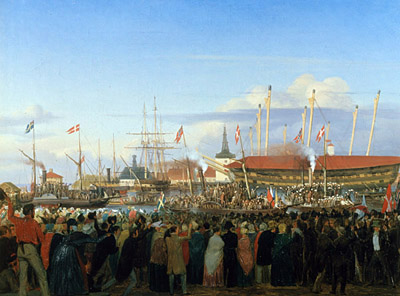
| | Studenter, dampskibe og flag ved studentermødet i København 1845. Her begyndte skandinavismen at få et politisk anstrøg, hvilket regeringen ikke brød sig om. (Jørgen Sonne, Frederiksborgmuseet). |
Båndene styrkes
1834 arrangerede gymnastiklæreren ved Lunds Universitet, Gustav Johan Schartau, et olympisk stævne i Ramlösa udenfor Helsingborg. En ny nationalfølelse skulle skabes med folkefest og kæmpelege blandt ”Skandinaviens kraftfulde sønner”. Samarbejdet på videnskabernes område promoveres bl.a. kraftigt af danskeren Christian Molbech og mest betydning fik nok de naturforskermøder som efter tysk forbillede kommer i gang fra 1839, første gang i Göteborg. På dansk side får disse bestræbelser en samlende skikkelse i fysikeren H.C. Ørsted og hen ad vejen modnes tanken om fællesstudier på nordiske universiteter.

Nordisk naturforskermøde 1847 |
Faste forbindelser
1838, da der tilfældigvis var naturlig fast forbindelse over sundet, udnyttedes isen på en betydeligt fredeligere måde end i vinteren 1658. Nu 180 år senere vandrede studenter fra Lund over til den danske side Kontakter knyttedes og man betonede det fælles ophav og den fælles historien. Samme måned vandrede det frivillige brandkorps i Helsingborg med fakler over isen til Helsingør. Der blev holdt fest på Hotel d’Øresund og nogle uger senere svarede Helsingørs brandkorps med et lignende arrangement, som afsluttedes med fest på Hotel Mollberg. Skåler og hurraråb dominerede festlighederne.
Studentermøderne
Et nordisk tidsskrift, Brage och Idun ,blev udgivet fra 1839 af forfatteren Frederik Barfod, som stod frem ved flere skandinaviske studentermøder. I en digt, som han læste vid et møde i København 1842 blev den nordiske enhedstanke udtrykt meget tydelig:
”tredelt er Nordens stamme,
men roden er dog én,
og kronens løvtag samler,
til sidst hver stammes gren!”
Året efter, i 1843, arrangeredes et stort studentermøde i Uppsala. Rejse fra København blev arrangeret, givetvis med dampskib, og på vej stoppede man op i Kalmar. Det var naturligvis ikke nogen tilfældighed at man besøgte lige denne by, unionsbyen, hvor Danmark og Sverige forenedes i en fælles union 1397. Taler blev holdt af lundensiske og københavnske studenter, hvor man i forbrødringens ånd skitserede en ny union, denne gang bygget på liberalismens idéer. Hermed havde skandinavismen også fået en mere klar politisk undertone, men i det væsentlige var der dog tale om en sydskandinavisk bevægelse, mens Uppsala fokuserede mest på forholdet til Finland og man i Oslo var skeptisk med hensyn til fortsat tilknytning til Sverige.

Tre flag men et folk |
Stormøde i København
1845 fandt et stort skandinavistisk møde sted i København, dit studenter fra Uppsala, Lund og Christiania (Oslo) ankom med dampskib. At sejle med dampskib havde for skandinavisterne nærmest fået symbolværdi. Dampskibet var ligesom skandinavismen noget nyt og revolutionerende. Dampskibet skabte muligheder for mere regelbunden kontakt og havde på konkret vis atter forvandlet Øresund til et sammenhængende farvand.
Under Københavnsmødet i 1845 b lev der holdt masser af taler og det lykkedes de danske studenters talsmand, Orla Lehmann, i en berømt tale i Christiansborgs ridehus at få studenterne at føle dybt for den nordiske enhedstanke. Han blev bagefter tiltalt for omstyrtede virksomhed, men blev senere frikendt.
Mødet i København varede en uge og det afsluttedes, som sig hør og bør, i Tivoli, hvor forlystelsesparkens grundlægger, Georg Carstensen, tog imod. I hele ugen bølgede følelserne omkring enhedstanken og hurraråbene rungede imellem skåler og pokaler. Man fremviste på gader og stræder sit skandinavistiske sindelag og gik syngende arm i arm til forskellige møder. Det var ingen hemmelig, sekterisk gruppe som samledes, man ville vise offentligheden hvad man ville og til og med inddrage dem i den nye samhørighed. Sammenkomster på torve og i parker medførte gjorde at det offentlige rum anvendtes i propagandistisk øjemed.

Studentermødet i København 1845 | 
Orla Lehmann | 
Studenter ved Frederiksborg Slot | 
Stockholm 1856 | 
Studentermøde i København 1862 |
Politisk røre
Fra begyndelsen havde man først og fremmest betonet den fælles kulturarv, men det kom, frem for alt i Skåne og på Sjælland, også mere og mere til at handle om en politisk skandinavisme. Det var denne politiske variant, som bidrog til at skabe uro i regeringskredse. Både den enevældige Christian 8. og Karl 14. Johan med hans ”alenestyre” hade hele tiden været mistænksomme overfor bevægelsen. I Danmark var det vanligt at skandinavister var under politibevogtning.
I det hele taget var der, på grund af begivenhederne omkring Norge, dårlige politiske relationer mellem Danmark og Sverige på det officielle plan, men da Oscar I efterfulgte sin far som konge af Sverige i 1844 forbedredes forholdet betydeligt og at den svenske konge aflagde officielt besøg i København var nærmast sensationelt. Det var ikke sket siden Gustav 3. s besøg 60 år tidligere.
Skandinavismens talerør
I Helsingborg hade Øresundsposten indledt en livlig pro-dansk propaganda og avisen blev et vigtigt talerør for skandinavismen i et par årtier. Den ansvarshavende redaktør, udgiveren og digteren, Oscar Patrick Sturzenbecker, fortjener særlig opmærksomhed. Han stammede fra de litterære kredse i Uppsala ved Stockholm, hvor han bl.a. skrev causerier i Aftonbladet under pseudonymet ”Orvar Odd.”.
1844 flyttede han til København, deltog i studentermødet 1845 og engagerede sig mere og mere i skandinavismens sag og slog sig 1847 ned i Helsingborg og grundlagde der Øresundsposten, som fik et radikalt liberalt og skandinavistisk præg og som derfor udviklede sig til Sveriges måske mest bemærkelsesværdige landsdelsavis.
Navnet på avisen skiltede åbenlyst med det politiske budskab. Sturzenbecker (senere Sturzen-Becker) gik ind for svensk deltagelse i den dansk-tyske krig i 1848, han propaganderede for et skandinavisk statsforbund og han havde hele tiden tætte kontakter med sine danske meningsfæller. Man kan nok påstå at de førende våbendragere for de skandinavistiske idéer i Sverige var de akademiske kredse i Lund og Öresundsposten i Helsingborg.

Oscar Patrick Sturzen-Becker | 
Öresundsposten |
Revolution og borgerkrig i Danmark
Da enevælden ophørte i Danmark i revolutionsåret 1848 øgedes skandinavismens muligheder yderligere og den nye konge i Danmark, Frederik d.7., havde ligesom sin svenske kollega et helt andet syn på skandinavismen end ved deres fædre havde haft. Den politiske skandinavisme gik nu så langt at svenske tropper udlovedes til hjælp i den dansk-tyske krig 1848.
Dette medførte stor entusiasme omkring Øresund og som eksempel kan nævnes at flere hundrede helsingørborgere en søndag i begyndelsen af maj 1848 drog over til Helsingborg for at fejre at et svensk troppekontingent skulle landsættes i Danmark! En stor fest sammen med helsingborgborgere blev arrangeret på hotel Mollberg.
De svenske soldater placeredes på Fyn, men blev dog aldrig sat aktivt ind i krigen, som afsluttedes med våbenstilstandsforhandlinger i Malmø i sensommeren 1848. Svenske tropper gjorde vagttjeneste i vinteren 1849-50 frem til krigsafslutningen.Unionstanker
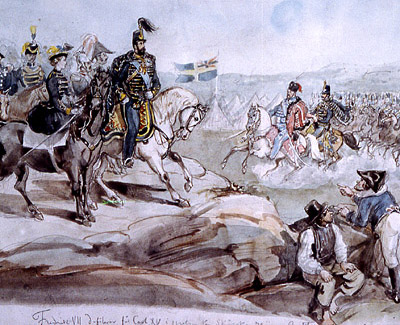
| | Omkring 1850 var de kongelige på begge sider af Øresunds positivt stemt overfor skandinavismen og en ny nordisk union med fælles kongehus diskuteredes seriøst. Kongerne tog også velvilligt imod studenterskandinavisternes deputationer, men det kneb mere med opbakning til de dansk-tyske opgør i 1848 og 1864. |
Personalunion i sigte
Efter afsættelsen af den svenske konge Gustav IV Adolf, vælges en dansk prins Christian August til tronfølger, men efter hans bratte død indsættes en tidligere fransk general, Bernadotte på tronen. Bernadotte konverterer til den protestantiske tro på det svenske konsulat i Helsingør og sætter herefter over Sundet.
Enhedstankerne trivedes i 1850erne også ved det svenske og danske hof og førte der så langt at man diskuterede en personalunion under en svensk konge. Frederik d.7. var nemlig barnløs og det var da nærliggende med en fælles konge for Sverige, Norge og Danmark. Denne union ville så kunne spille en vigtigere rolle i europæisk storpolitik. Dette havde Europas stormagter givetvis også synspunkter på og man mente der at det danske monarkis integritet burde bevares. Dette blev fastslået på konferenser, som blev afholdt i London 1850 og 1852.
Ny dansk kongeslægt
Tronfølgen i Danmark flyttedes imidlertid over på prins Christian af Slesvig-Holstein-Sonderburg-Glücksburg og hans efterkommere. Måske var dette tidspunkt - med problemerne omkring Danmarks sydgrænse og den uklare arvefølge efter den barnløse Frederik d.7.- det afgørende for en mere omfattende skandinavisk samling, som for altid forpassedes med vedtagelsen af den danske tronfølgelov af 1852, hvorefter glücksburgeren Christian d. 9. skulle efterfølge Frederik d.7.
Mange danskere var imidlertid skeptiske overfor denne Christian som ny konge og at Frederik d.7. foretrak en svensk tronfølger frem for den danske Christian var helt åbenlyst. Både Oscar I og Frederik d.7. sigtede på en personalunion. En livlig propaganda gennemførtes i Europa for at få stormagterne til at anerkende en dynastisk forening imellem de nordiske lande. Mange (bl.a. Sturzen-Becker) skrev indlæg for at bearbejde den europæiske presse. Da Oscar I blev syg og døde i 1859, overtog sønnen Karl XV styret og unionsplanerne.
Gemytligt venskab
Personkemien imellem den nye svenske kong Karl XV og Frederik d.7. var endnu bedre. De træffedes flere gange, bl.a. på Ljungbyhed i Skåne 1860, i sammenhæng med studentermødet i København 1862, samt ved et stort møde i Skodsborg 1863 og samme år også på Bäckeskog i Skåne. En gemytlig venskab mellem de to konger opstod og forudsætningerne for en personalunion syntes gode. Karl var med sin folkelige stil desuden populær i både Danmark og Sverige. Han var også rundhåndet med sine løfter til danskerne og gav, i sammenhæng med mødet i Skodsborg, et mundtligt løfte om svensk militært støtte til Danmarks forsvar af dets sydgrænse, som nu på ny truedes af tyskerne.

Karl 15. og Frederik 7. | 
Karl 15. og Frederik 7. | 
Karl XVI i Helsingør | 
Fredensborg slotspark 1862 |
Brudte løfter
Dog, løfterne blev ikke indfriet da den dansk-tyske krig brød ud i 1863. I første omgang støttedes kongen af udenrigsminister Mandelstrøm og den svenske gesandt i København Hamilton, men blev senere underkendt af statsrådet. Den svenske regering meddelte at man ikke havde tænkt sig at sende tropper, en beslutning som gik stik imod med Karl XV: s ønsker. Midt i denne politiske turbulens døde Frederik d.7. og Christian 9. blev konge i Danmark. Unionstanken begyndte på grund af de svegne svenske løfter, den svenske regeringens mistro og den nye danske konges negative indstilling at svinde bort og skandinavismen mistede terræn.Drøm og virkelighed
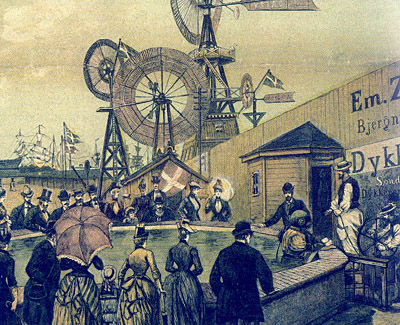
| | Med det danske nederlag til Tyskland i 1864 blev skandinavismen sat tilbage, men i årene herefter kom der nye tiltag og en stadig voksende kulturel udveksling. Den første skandinaviske Kunst- og Industriudstilling fandt sted i København 1872.
Indenfor arkitekturen blev der udviklet fælles stiltræk og København blev centrum for det moderne gennembrud indenfor litteratur og kunst og tiltrak kunstnere fra hele Skandinavien. |
Skandinavismen – en fælles fiasko?
Skandinavismen var ikke noget færdigt politisk program, som man forsøgte at gennemføre. Skandinavisterne træffedes nu og da og efterhånden kom der nye idéer, sympatisører og symboler til. Det begyndte som en kulturel manifestation i de litterære kredse, udviklede sig til en virkelig fællesskabsfølelse med skåler og hurraråb i mængder blandt studenter og borgerskab og udviklede sig til en politisk enhedstanke, hvor ikke mindst kongerne havde vidtrækkende unionsplaner, som til sidst sønderlemmet af den europæiske storpolitiks virkelighed.
Man kan diskutere, hvor stærk den indbyrdes vilje og sammenhold egentlig var. Når og hvis man sammenligner med andre samtidige samlingsbestræbelser i Tyskland og Italien - som vel at mærke lykkedes - er det ikke fordi de politiske religiøse, kulturelle og sproglige forskelle var større - snarere tværtom. Et andet spørgsmål er omverdenen, i særdeleshed de europæiske stormagters holdning. Sikkert er det, at Rusland og for den sags skyld også Preussen ikke så med blide øjne på en samlet beherskelse af Øresund og hermed indsejlingen til Østersøen – med andre ord det klassiske problem i europæisk storpolitik vedrørende Øresunds- og Østersøregionen. Men ville de europæiske stormagter i givet fald have trodset folkets vilje i nationalliberalismes tidsalder?
Kunst- og industriudstillinger
På det økonomiske plan fik skandinavismen en vis gennemslagskraft, hvilket bl.a. manifesteres ved afholdelse af en skandinavisk Kunst- og Industriudstilling i København i 1872. Tanken om en fælles toldunion manes i jorden, men i 1873 skabes en skandinavisk møntunion med fælles værdi og fælles valutastrøm. Man behøvede altså ikke veksle penge indenfor Skandinavien og kursen var altid 100/100.
I 1888 afholdes atter kunst- og industriudstilling i Købehavn og fra 1889 stammer de første planer om en fast forbindelse over Øresund i form af en jernbanetunnel ved Helsingør – Helsingborg. Forslagsstilleren er en svensk ingeniør, Rudolf Lilljequist, som vil bringe ”Stockholm, Kristiania och Kjöbenhavn uti direkte järnvägsforbindelse med Hamburg, Berlin og Paris etc...” Det skulle blive det første af mange forslag til en fast forbindelse over Øresund.

Skandinavisk udstilling 1888 | 
Udstillingsbygning 1888 | 
Udstillingsbygningen | 
Fast forbindelse 1889 |
Monument for Slaget ved Lund
Den 4. december i året 1876 på 200årsdagen for slaget ved Lund startede en kreds af skandinavistisk indstillede en indsamling med henblik på opstilling af et mindesmærke på stedet hvor omkring 9.000 danske og svenske måtte lade livet i et blodigt indbyrdes opgør. Hensigten var vel at mærke ikke at fejre den knebne svenske sejr i slaget, men at skabe et fælles mindesmærke over begivenheden.
Monumentet blev tegnet af arkitekten Helgo Zetterwald og udført i den industrielle tidsalders materiale beton, som desværre forvitrer, således at en kopi i solid granit måtte opstilles i 1930. Indvielsen fandt sted ved en fælles dansk-svensk studenterfest i året 1883 og taler ved begivenheden var formanden for de skånske landskabers historiske og arkæologiske forening Martin Weibull.
Karakteristisk for denne begivenhed er nok dens forankring i det regionale, i de dansk-skånske relationer, som på forskellig vis tager et opsving omkring dette tidspunkt. Kredsen omkring Weibull og en række andre akademikere ved Lunds Universitet er ledende i disse bestræbelser, som tager sigte på at opdyrke den skånske kulturarv og historie. I så henseende kan man selvfølgelig ikke komme udenom de mange hundrede års fælles dansk-skånsk historie frem til 1658 og det giver sig også udslag på forskellig vis.

Monument for slaget ved Lund | 
Monument for slaget ved Lund |
|